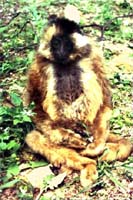Stories of the Vietnam Vets’ Rock Apes
Posted by: Loren Coleman on November 11th, 2010
Only the occasion of Veteran’s Day, 2010, I repost this earlier offering, along with the January comments it got. It seems appropriate to have the blog talk about this topic on this day.
In the book, Very Crazy GI – Strange but True Stories of the Vietnam War, Vietnam War veteran Kregg P. J. Jorgenson tells of how he had an actual sighting of a short, red-haired, hairy, upright anthropoid, which he says soldiers in Vietnam called a “Rock Ape.” One even was said to be captured in Dak Lak Province in 1971, and in 1974 a North Vietnamese general, Hoang Minh Thao, requested an expedition to find evidence of the creatures, but it was unsuccessful.
Other soldiers, we are told, down through the years, have told of their own Vietnam War era encounters with these cryptids.
Incidents are to be found on the Internet, such as this one here:
All except one was light brown to reddish brown in color, and about 3 1/2 four feet tall. One dark, almost black, male remained fighting to protect the others retreat and he was flying through the branches and rushing the men with his teeth bared. He was one very brave animal, I’ll tell you that.
And here:
When Poncho got control of himself, he told me that he had been walking back to the bunker when he noticed a bush that hadn’t been there before. He bent over to see it better and it SNORTED at him and he fired. What he had encountered was the ubiquitous Rock Ape of Vietnam. I would come to learn that they were nearly everywhere, and quite fearless. That is what we had heard near the wire that night.
Names like “Monkey Mountain” apparently referred not to local monkeys but to the Rock Apes.
What is unique about these references is that I understand them to have turned up in books that were Vietnam conflict books that had nothing to do with cryptozoology, by guys that merely recounted these stories casually, from their pasts. At one time, I heard that a few people (Australian, Vietnamese) who were actively searching out these remembrances.
Are Rock Apes misidentified gibbons?
There has even been speculation that they might be gigantic orangutans.
Considering that many Vietnam War vets are creeping up in their years, I wonder what the status of the rumored project is.
Anyone hear?
Where is a book compiling all these “Rock Ape,” Nguoi Rung, and/or Batutut reports?
About Loren Coleman
Loren Coleman is one of the world’s leading cryptozoologists, some say “the” leading living cryptozoologist. Certainly, he is acknowledged as the current living American researcher and writer who has most popularized cryptozoology in the late 20th and early 21st centuries.
Starting his fieldwork and investigations in 1960, after traveling and trekking extensively in pursuit of cryptozoological mysteries, Coleman began writing to share his experiences in 1969. An honorary member of Ivan T. Sanderson’s Society for the Investigation of the Unexplained in the 1970s, Coleman has been bestowed with similar honorary memberships of the North Idaho College Cryptozoology Club in 1983, and in subsequent years, that of the British Columbia Scientific Cryptozoology Club, CryptoSafari International, and other international organizations. He was also a Life Member and Benefactor of the International Society of Cryptozoology (now-defunct).
Loren Coleman’s daily blog, as a member of the Cryptomundo Team, served as an ongoing avenue of communication for the ever-growing body of cryptozoo news from 2005 through 2013. He returned as an infrequent contributor beginning Halloween week of 2015.
Coleman is the founder in 2003, and current director of the International Cryptozoology Museum in Portland, Maine.














Back in the 90’s, I worked with a retired Navy Captain. He spent two years in Vietnam and his first year there, he was a Jag officer. Shortly after arriving, he had gone to a forward location to investigate a case. During the night, a sentry spotted what he thought was a group of Viet Cong trying to get thru the perimeter defense wires. They opened up on them, only to find out that they had killed 12 “Rock Apes”. He swore that they were as big as a man and walked upright. Apparently, they were so common, it was no big deal to see them almost daily.
My stepdad was in Vietnam and he’s very coherent, no PTSD or anything, and he’s told stories about them. He said they were very tall and I doubt they would mistake a wide, orange orangutan for a skinny vietnamese man. There were corpses piled up, of course, from night time shoot-outs. I wonder why so many people don’t believe in them. I think it’s pretty obvious they exist/ed.
My grandfather Airforce Master Sargent Richard Duane Locke told me about these apes. He said they looked like old men. He also said a few times when they threw grenades and such the rock apes would throw them back. From what he tells me they were a common sight. I never knew that these were cryptids, I thought they were commonly known to science. If Loren is interested my grandfather would be happy to tell him about these apes.
A big, cryptic Vietnamese species of gibbon would be an interesting possibility that doesn’t seem like too much of a stretch.
Lots of other stuff floating around about Vietnam. Martin Caidin reported a story with a seemingly supernatural aspect, of large, aggressive ape-things that almost completely ignored being hit repeatedly at short range with automatic weapons. That one’s kind of hard to take.
Then we have Heuvelmans’ suspicion of a Vietnamese origin for the Minnesota Iceman. I’ve never read, though, that he had a first-hand or even second-hard report of this specific creature being killed and smuggled in.
Needless to say, of course, I would appreciate firsthand accounts from Vietnam War vets on what they saw, when, where, and by whom, regarding the sightings of “Rock Apes.”
I can be reached at Loren Coleman, PO Box 360, Portland, ME 04112, for those who wish to snail mail in their accounts. (Email contacts via Cryptomundo are blind alleys, as often hotmail, yahoo and similar email addresses bounce back.)
If anything wouldn’t they just be refered to as Orang Pendek? I remember on the MonsterQuest episode about Orang Pendek they had an account from a Vietnam vet who saw one in a tree while he was in a helicopter. Also I don’t understand if they were seen by so many people on so many occasions, often times traveling in large groups and were even mistaken for NVA and engaged by American forces there is no existing proof such as photos, video, or corpses.
I would say given the politics of the time and fact it was a full blown war taking pics of apes wasn’t high on many peoples list of priorities. I’m willing to bet there specimens in museums collecting dust in storage and long forgotten and ignored.
This story sure shakes out a few old neurons of memory.
One of the guys from our neighborhood went to Nam, did his time and came back. I was about 11 or 12 years old at the time, and some family and friends came over with this war vet, and the conversation turned to the war. Nothing heavy or anything like that, more about the culture, the heat and humidity, sweating yourself clean and all that.
I remember distinctly when he began to lightly touch on some of the patrols he went on, and then he said something I have never forgotten. He said something to the effect of, “You know what the worst thing about being on a patrol was? The damned rock apes. They’d jump out from anywhere and scare the hell out of everyone. Ya couldn’t shoot them because it would give away your position, so we just had to keep moving while they hurled branches, sticks and rocks at us.”
Needless to say, this fascinated me more then the war did, and he clarified the fact that the reason they were called rock apes was because that’s what they threw at the soldiers.
I have, until this day, always wondered what a rock ape was, and from reading the posts, it appears to be some type of cryptid. I never would have guessed.
It came to the attention of Dr. Bernard Heuvelmans and researcher Ivan T. Sanderson in 1968, both of who studied and photographed the creature as best they could in the ice, and were convinced that it was a real body of an unknown primate. Hansen claimed that the creature had been killed in Vietnam.
Heuvelmans guessed that the creature had been murdered in Vietnam during the war and smuggled into the United States in a “body bag.”
I know that different versions on the creatures origin were given but maybe,just maybe one of them was true.
My grandfather told me stories just like the ones above. The only thing is that he wasn’t in the jungles of nam but all his friends were. I did not believe his stories because he also told me of how the US was covering up area 51 all the time. He was in the airforce during nam but never did he see one himself. He does not drink or have history of mental illness but he is 100% sure that ufos are being hidden from us.
MattBille brings up an interesting report concerning the rock apes being seemingly impervious to bullets. Of course it is hard to take, but it strikes me that this characeristic has been reported in accounts of other hairy hominids as well.
There have been accounts of Sasquatch, for instance, that describe the animals being shot, sometimes at fairly close range or with large caliber rounds, yet seeming to show no adverse effects and leaving no blood behind. If I remember correctly, there are similar Yowie reports as well.
Now of course I think that the idea of a bulletproof hairy hominid is a bit silly, however the reports do exist and it seems that if we don’t just toss these accounts, then it is worth trying to think about what is going on in these instances.
For example, It could be that the creature wasn’t hit at all or that like sometimes happens with large animals such as bears it was able to only seem to shrug off the shot from a round or hit that was insufficient to imediately take it down.
These sorts of report are sort of an enigma to me, but I suspect that if they are to be believed and the creatures are indeed real, then there is some rational explanation and not necessarily a supernatural cause at work.
You know, there’s an aspect of this I never thought about.
THERE WAS A WAR ON. IN A JUNGLE.
The only thing any Westerner in Vietnam cared about was that war. The animals? Whatever. What did any American know, back then, about jungles? (Other than the relatively few biologists working in them.) You could see ANYTHING in that hot steamin’ stinkin’ jungle….or ANY hot steamin’ stinkin’ jungle…as far as those kids (or their superiors) were concerned. A hundred-foot centipede – or a pterosaur – probably would have been greeted with standard-issue jungle-critter reaction. They probably didn’t see anything particularly interesting or unusual about “those damned rock apes” at all. But quite a bit that was annoying, and even dangerous. Like anything – everything – in a jungle can look to someone not used to being there.
It may be possible that no one thought these animals were unusual enough to remark upon. After all, when you’ve seen one orangytang, you’ve seen ’em all, right?
(Another question the answer to which would interest me: how many servicemen in Indochina saw saola – an animal not confirmed until almost 20 years after the war?)
I agree with DWA. I suspect that most of the creatures the GI’s saw in the jungle over there were “strange” to them. After all, American forces in Vietnam were literally “strangers in a strange land”. They would have had no basis of knowledge on which to determine which animals were noteworthy and which were not.
Very interesting story.
My only question is, if these “rock apes” were common and many were killed…Where’s the pictures? I am sure that there would be at least one photo, somewhere, of one of these creatures or their carcass. It doesn’t make any sense why there isn’t at least one. Can someone explain that to me, maybe I am a little naive.
This brings up an interesting point about war and cyptids.
With so many people occupying remote jungle locations coupled with massive disruption/destruction of habitat it is possible that a normally reclusive primate species could possibly be flushed out and encountered frequenty during that period.
Makes you wonder if a battle took place in the Pacific Northwest would we encounter Bigfoot, as a result?
Interesting post and quite timely as far as I am concerned. I just finished watching a TV program about them on SyFy Rewind about the Vietnamese Wildman. The show actually had a guest appearance by Jeff Meldrum.
The show is a bit over the top for me and some of it is forced to fit the program. Nonetheless, it was interesting for other reasons. They even had a former soldier talking about them and some locals.
My uncle did two tours in Nam and I am sure I remember him saying that it was forbidden for GIs to have cameras “in country”. If that is true I think that would go a long way to explaining why there are no rock ape pictures, or at least why any pictures have not surfaced yet.
I’m really glad to read all these reports because I knew a vet a while back who insisted there were orangutans in Viet Nam when he was serving there. But, until now, I’d never heard anyone else talk about reddish human-sized (or larger) primates there.
I don’t know how I’ve missed these reports with the number of books on Vietnam I’ve read, but I have to agree with the above statements that those (mostly young) soldiers saw anything unusual as just another part of Vietnam. How would you know what animal was unusual when everything was new to you?
As to animals taking hits and continuing on, that touches on something that my cousin and I were discussing earlier while sighting in for deer season. His son took a deer during youth season, destroying the heart with a .270. The deer made it 75 yards before falling. 75 yards in an overgrown jungle might as well be a mile and I doubt you’d be able to locate a body even if you were so inclined to look for one, which I’m sure they weren’t. The 5.56 round used by the military in the M16A1 then and the M16A4 now isn’t even designed to be a great killer – it was designed to tumble in the body, leaving a messy wound, with little hydrostatic shock. There are plenty of verified, and in some cases, filmed, stories from Vietnam to Afghanistan of enemies taking several rounds and continuing the fight. Now, if there were verified reports of them shrugging off 7.62 rounds from an M60 or M14 at close range, I’d be impressed. I don’t think I’d ever believe anybody saying they shook of a .50 to the body. Maybe the reason they dropped so many near bases was they had the heavier firepower necessary to stop a largish animal in its tracks? No looking through a jungle to find the body, either.